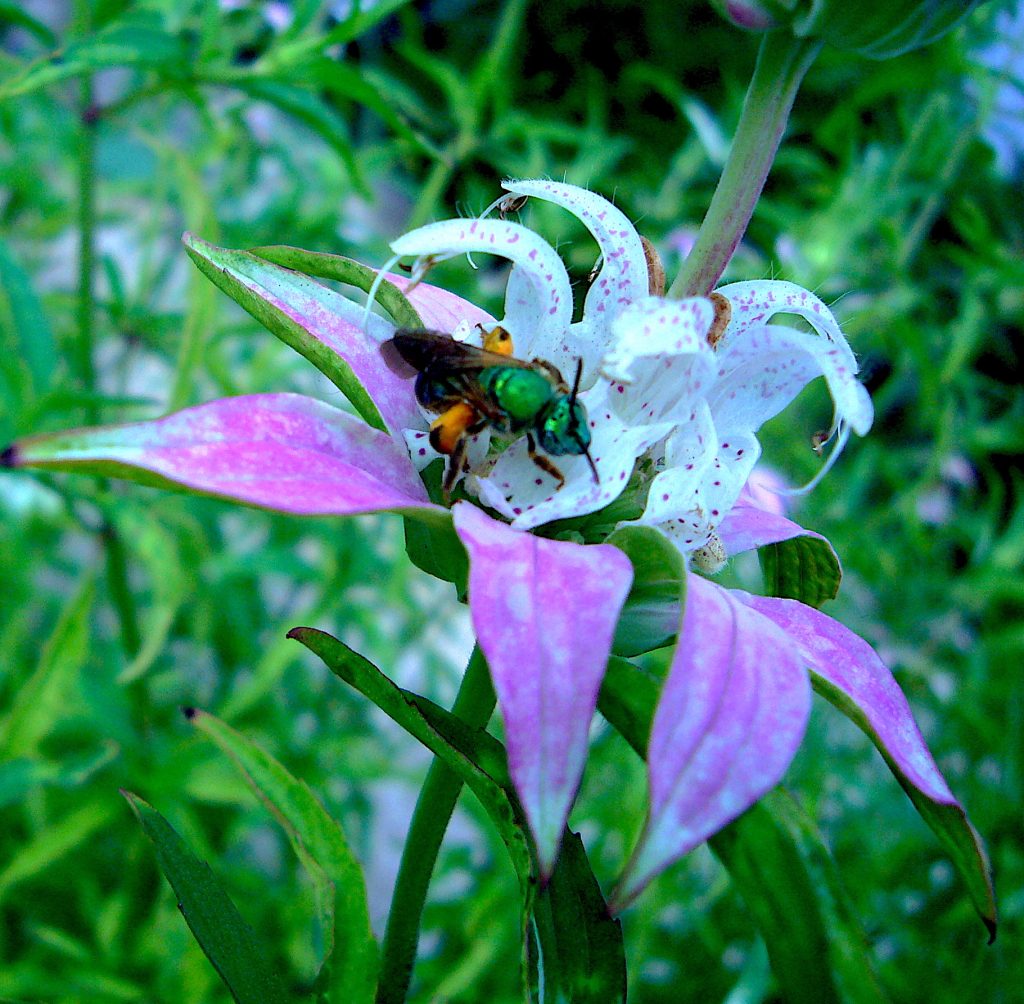
Monarda punctata, Horsemint, Beebalm, Oswego. Photo by Green Deane
There’s a wonderfully aromatic plant that prefers to hide most of the year. If you know what it looks like and the habitat it populates you can find it. But this time of year and into the early fall it’s waving at you saying “look at me!” This past week in our foraging class in Ft. Pierce we saw Horsemint, Mondarda punctata, just starting its extroverted stage. When the species is ready to be pollenated it really wants bees and other insects to find it by developing pink bracts (which look like extra leaves below the blossom.) Monarda punctata is in a large group of wild mints known for their showy display. Some relatives are called Mountain Mint or Scarlet Beebalm and grow to five feet tall or so. Where I grew up it was called Oswego Tea. Its active ingredient is thymol. You can read about it here.
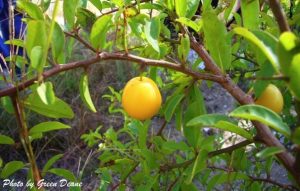
Tallow Plum or commonly one of the many “hog plums” Photo by Green Deane
Thorny Tallow Plums are nearly ripe. During our foraging class last weekend in Ft. Pierce we found a Tallow Plum with ripening fruit, not quite ready to eat. I’ve found them in two coastal locations nearly ready to eat. The one inland Tallow Plum I know — west Orange County — of is still blossoming. Despite being rather common (as coastal shurbs) there is still much that is not know about the Tallow Plum. It can be clones and it can be parasitic, or it can be free standing on its own. When you find one you usually find several… or more of the same plant just spread out though that might be just a costal behavior. The one inland example I know is lonely. As many of you know my sites do not allow Wikipedia entries (because when it comes to foraging their entires are usually more wives tales than information you can really use. ) I notice their picture of Tallow Plum has red-orange fruit, an uncommon exception. A yellow fruit picture would be more representative of the species as orange fruit is vey rare. Eat the fruit in moderation. Do not eat the leaves. They contain a chemical which on digestion becomes cyanide. Also don’t eat the seed, plant it. You can learn more about the Tallow Plum here.
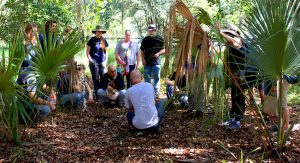
OMG! The Orlando Mushroom Group in the field collecting mushrooms. Photo by Green Deane
The Orlando Mushroom Group (OMG!) had its third fungal foray Sunday to great success. Nearly two dozen folks turn out for the hunt a few miles west of Sanford. Joshua Buchanan was the resident mushroom expert. Everyone who wanted to went home with some chanterelles to try. They weren’t the only edible species found. Gem-studded Puffballs also got picked along with two or three species of Milk Caps (which do not have a common name among them. More confusingly they all used to be Lactarius and now they are Lactarius and Lactifluus… yes, with two “U’s”… Dead Latin spelling rules…) We also saw some medicinal mushrooms — local Reishis — and Boletes to use the edibility test on. If you have forgotten the Bolete Edibility Test it is: The Bolete is not edible if it has an orange cap, orange pores, red pores, stains blue and or is bitter. (That does eliminate some edible ones but it does get rid of all the toxic ones.) There were also several deer. They go well with mushrooms, too. Joshua also got to show the mushroom he makes a fire cloth out of and the wild mushroom you can use for fish bait. You can follow the Orlando Mushroom Group on Facebook. Or, as we now own OrlandoMushoomGroup.com, if anyone is interested in building a website for the group please let me know.
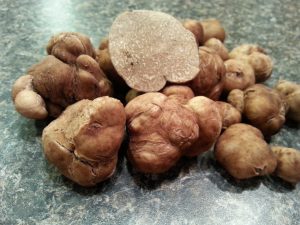
Edible Pecan Truffles, Tuber lyonii.
Did you know truffles grow in Florida? They had been on my list to do since last fall when in Gainesville I noticed a mycology professor with a sturdy, short rake… well, it’s kind of hard to not to notice a mushroom professor carrying a chunky Viking-esque hand rake… it resembled a flat-bladed calm hoe (for you New Englanders who know what backbreaking work digging clams are.) When I inquired he told me he had been hunting truffles. He was looking for the right combination of tree, landscape, and signs of other creatures looking for the fungus, too. One edible species is the Pecan Truffle, Tuber lyonii. It’s called that because it was first noticed in Pecan orchards. Not the same flavor as European Truffles — more nutty — but it still fetches some $200 a pound. They are also found with hickories, oaks, hazels, basswood and chestnuts (which suggest that at one time they were very prolific as chestnuts were the dominant tree species in eastern North America.) Subterranean Pecan Truffle are usually found near the surface, which is why you use a rake instead of a shovel to find them. Surprisingly the truffles are found more often with younger trees. Perhaps that is the age that benefits them both the most from their ectomycorrhizal relationship (the fungus supplies nutriments to the tree and the tree provides sugar and moisture.) Ectomycorrhizal is from three Greek words meaning “outside” “fungus” and “Root.” The fungus creates a netting-llike pattern outside the root (vs. invading the root) and they exchange needed material. Florida is fortunate in that the truffle season lasts from August to December and if the winter is mild sometimes into February. The truffles take a break between March and June. We do have three truffle-looking fungus that you should not mistake for truffles: Hymenogaster, which smells like radishes, Pig Skin Puffball, which when mature has a thick skin and is purple inside, and Dead Man’s Foot (and other names.) It is a Pisolithus with what looks like pearls of grain inside. Dogs can be trained to find Pecan Truffles… sounds like a good excuse to add a new four-footed member to the family. But it has to be one with a good nose…
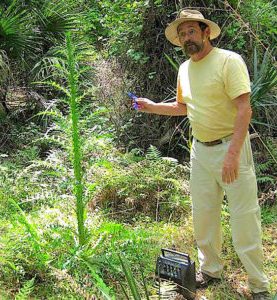
Foraging classes are held rain or shine, heat or cold.
Foraging Classes: Two central Florida classes this weekend, Orando and Ocala. Foraging class in Ocala used to be common on my schedule when I had a place to stay there thus I would do Ocala and Gainesville on the same weekend. Now Ocala is about three times a year so this is a good time to see what that area has to provide. The other class is in Blanchard Park here in Orlando. It’s an easy park to walk around with a wide variety of edibles.
Saturday, July 7th, Blanchard Park, 10501 Jay Blanchard Trail, Orlando, FL32817. 9 a.m. Meet at the pavilion east of the tennis courts near the YMCA.
Sunday, July 8th, Jervey Gantt Recreation Complex, 2390 SE 36th Ave., Ocala, FL, 34471. 9 a.m. Meet at the entrance to the pool, aka Aquatic Fun Center.
Saturday July 14th, Seminole Wekiva Trail, Sanlando Park, 401 West Highland St. Altamonte Springs, Florida 32714. 9 a.m. Meet at the first parking lot on your right after entering.
Sunday July 15th,Eagle Park Lake, 1800 Keene Road, Largo, FL33771. 9 a.m. Meet at the pavilion near the dog park.
Saturday, July 21st, Bayshore Live Oak Park, Port Charlotte, Fl. 9 a.m. Meet at the parking lot at the intersection of Bayshore Road and Ganyard Street.
Sunday July 22nd, Lake Woodruff National Wildlife Refuge, 2045 Mud Lake Road, DeLeon Springs,FL. 9 a.m. Meet at the parking lot on right after crossing the railroad tracks. It will be a long, and hot class. Bring water. Bathrooms are port-O-lets.

Green Deane DVD set of 135 videos
All of Green Deane’s videos available for free on You Tube. They do have ads on them so every time you watch a Green Deane video I get a quarter of one cent. Four views, one cent. Not exactly a large money-maker but it helps pays for this newsletter. If you want to see the videos without ads and some in slightly better quality you can order the DVD set. It is nine DVDs with 15 videos on each. Many people want their own copy of the videos or they have a slow service and its easier to order then to watch them on-line. They make a good gift for that forager you know. Individual DVDs can also be ordered. You can order them by clicking on the button on the top right of this page or you can go here.
For more information about the classes go here.
This is (a short holiday) weekly issue 311.
If you would like to donate to Eat The Weeds please click here. Or you can use my Go Fund Me link, or by writing to Green Deane POB 941793 Maitland FL, 32794.


I am a web developer by trade. My portfolio site is http://www.StudioRyu.com.
Please pass my info along to the Orlando Mushroom Group if they are still in need of a web site.
-Rudy
I always enjoy reading your newsletters.
Thank you!